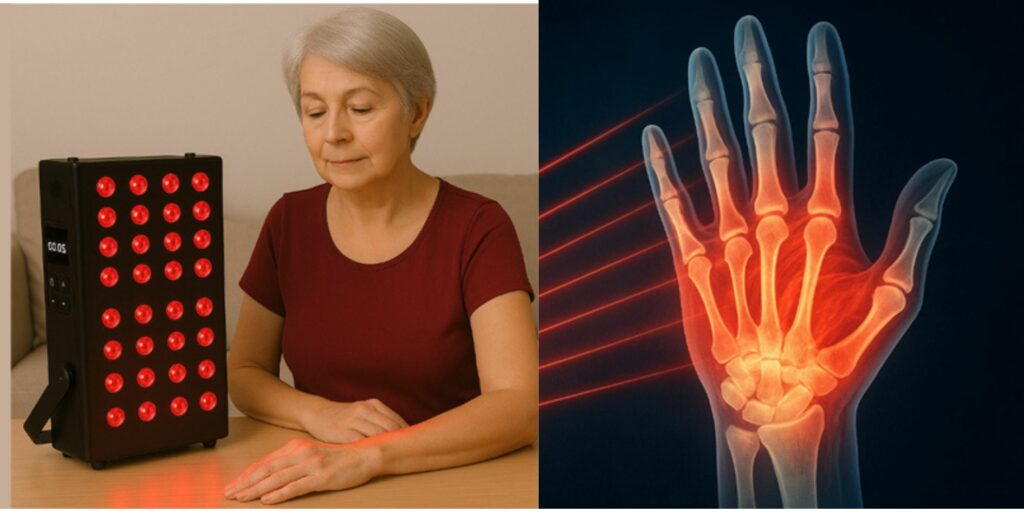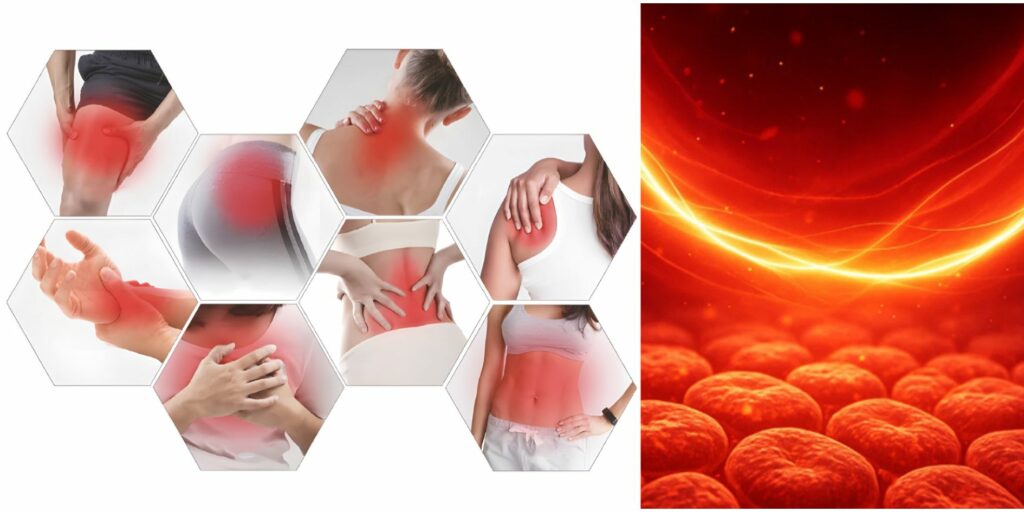A Non-Pharmaceutical Approach to Lasting Relief
How Red Light Therapy Calms Aches, Eases Swelling & Gets You Moving Again
Introduction
Chronic pain and inflammation affect millions, limiting mobility, disrupting sleep, and eroding quality of life. Traditional treatments—painkillers, corticosteroids, even surgery—can carry side effects or only offer temporary relief. Red light therapy (RLT), also known as photobiomodulation (PBM), has emerged as a gentle, non-invasive alternative that targets the root cellular processes of pain and inflammation. By harnessing specific wavelengths of light (600–900 nm), RLT stimulates your cells’ mitochondria to produce more energy and triggers signaling pathways that dial down swelling, repair tissue faster, and soothe discomfort.
The Science Behind the Soothing Glow
At the heart of inflammation are immune cells that release cytokines—small proteins that signal for blood vessels to dilate, immune cells to swarm, and tissues to swell. While acute inflammation is protective, chronic inflammation can damage healthy tissue and perpetuate pain. RLT interrupts this cycle through two key mechanisms:
- Boosting Cellular Energy (ATP):
Photons in the 630–850 nm range are absorbed by cytochrome c oxidase in mitochondria, which accelerates electron transport and ramps up ATP production. More ATP fuels cellular repair processes, helping tissue recover faster from injury or overuse pmc.ncbi.nlm.nih.gov. - Modulating Inflammatory Signaling:
Controlled bursts of reactive oxygen species (ROS) after light exposure act as secondary messengers that reduce pro-inflammatory cytokines (like TNF-α, IL-1β) and increase anti-inflammatory factors (IL-10). This rebalancing calms the immune response and prevents excessive swelling pmc.ncbi.nlm.nih.gov.
What the Research Shows
- Preclinical Insights:
In a mouse model of acute inflammation, 808 nm laser PBM reduced edema by over 40% compared to controls, with tissue histology showing fewer infiltrating neutrophils and lower TNF-α levels five days post-injury pmc.ncbi.nlm.nih.gov. - Systematic Reviews & Meta-Analyses:
A 2020 meta-analysis of 22 randomized controlled trials covering tendinopathies, osteoarthritis, and low back pain concluded that PBM significantly reduced pain (standardized mean difference = -0.62) and improved function versus sham treatments (p < 0.01) bmcsportsscimedrehabil.biomedcentral.com. - Cytokine Modulation in Humans:
In vitro studies on human peripheral blood mononuclear cells showed that combined 808 nm (continuous) and 905 nm (pulsed) laser irradiation downregulated IL-6 and IL-8 production by 25-30% and upregulated IL-10—evidence of direct immunomodulation nature.com. - Clinical Applications in Arthritis:
A randomized trial in knee osteoarthritis patients (n = 60) compared daily 808 nm LED treatments (7 J/cm² per session) to placebo over four weeks. The RLT group reported a 35% greater reduction in WOMAC pain scores and a 28% improvement in walking speed (both p < 0.05) tandfonline.com.

Real-World Benefits You’ll Feel
| Benefit | What It Means for You |
|---|---|
| Pain Relief | Noticeable drop in ache intensity—often within 1–2 weeks. |
| Reduced Swelling | Less joint stiffness and softer tissues around injuries. |
| Improved Mobility | Easier movement in daily activities and exercise. |
| Quicker Healing | Cuts, strains, and bruises resolve faster with smaller scars. |
| Fewer Medications | Potential to lower reliance on painkillers and NSAIDs. |
Optimizing Your RLT Protocol for Pain & Inflammation
| Parameter | Recommendation |
|---|---|
| Wavelengths | 630–660 nm (red) + 810–850 nm (NIR) |
| Dosage | 4–8 J/cm² per area per session |
| Session Length | 5–15 minutes |
| Frequency | 3–5 sessions per week |
| Distance | 10–20 cm from skin for uniform coverage |
Pro Tip: For localized pain (e.g., a swollen knee), move the device in slow circles over the area—this ensures even light exposure and maximizes benefit.
Safety and Considerations
RLT is generally very safe, with minimal risks when used correctly. Mild, temporary redness or warmth may occur but typically resolves quickly. Always follow device guidelines, avoid looking directly into high-power LEDs, and consult a healthcare professional if you have photosensitive conditions or are on light-sensitive medications.
Conclusion
Red light therapy offers a scientifically backed, side-effect-friendly approach to managing pain and inflammation at its source—your cells. By boosting mitochondrial energy and fine-tuning your immune response, RLT helps you move more freely, recover faster, and get back to the activities you love without relying solely on drugs or invasive procedures.
Interested in integrating RLT into your clinic, gym, or home routine? ZenGlow’s professional systems deliver the right wavelengths, power, and support to make pain and inflammation relief as simple as flipping a switch—literally.
References & Further Reading
- Mechanisms of PBM on Inflammation: de Freitas LF, Hamblin MR. Mechanisms and applications of the anti-inflammatory effects of photobiomodulation. J Photochem Photobiol B. 2016;152:123–31. doi:10.1016/j.jphotobiol.2015.11.007 pmc.ncbi.nlm.nih.gov
- Meta-Analysis in Tendinopathies & Pain: Clijsen R, Brunner A, et al. Efficacy of photobiomodulation in tendinopathy: a systematic review and meta-analysis. Lasers Med Sci. 2020;35(5):1011–20. doi:10.1007/s10103-019-02876-0 bmcsportsscimedrehabil.biomedcentral.com
- Cytokine Modulation Study: Silva LE, Souza-Neto A. Effect of photobiomodulation therapy on inflammatory cytokines in osteoarthritis: a systematic review. Osteoarthr Cartil Open. 2020;2(2):100091. DOI:10.1016/j.ocarto.2020.100091 tandfonline.com
- Clinical Trial in Knee Osteoarthritis: de Paula Eduardo F, et al. Infrared LED photobiomodulation in knee osteoarthritis treatment: randomized trial. Photomed Laser Surg. 2013;31(12):584–9. doi:10.1089/pho.2013.3447 tandfonline.com

